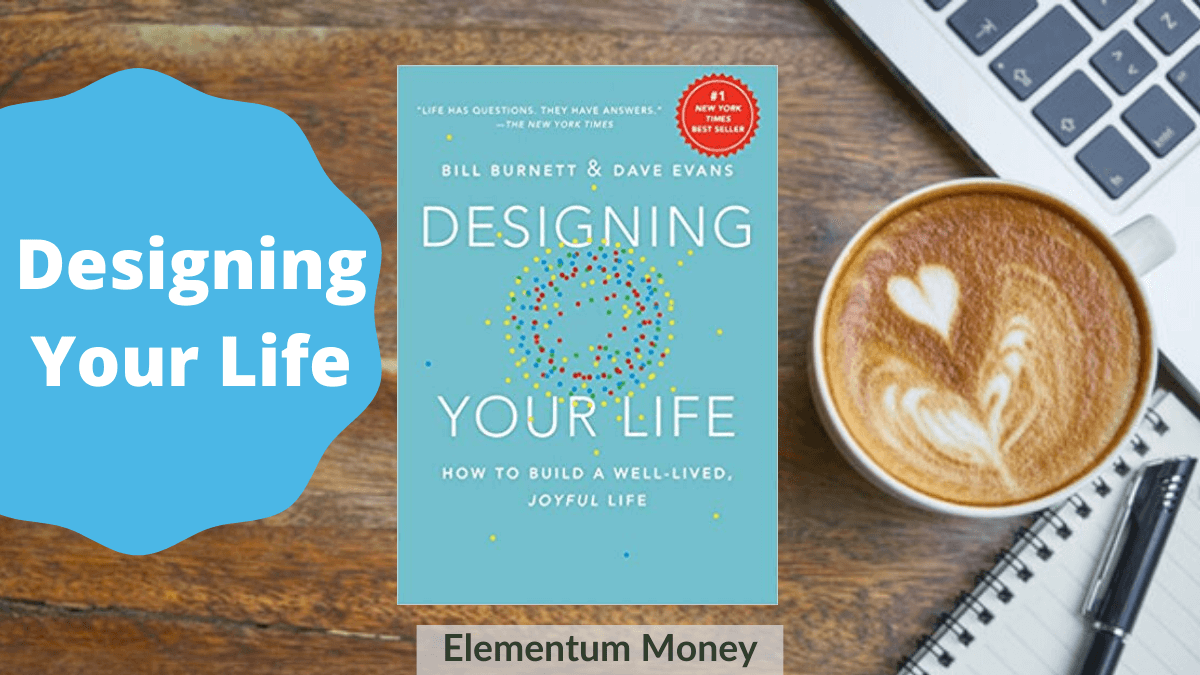It’s funny how you evolve as a person. Gone are the days when I used to scoff at Personal Growth books and the ideas that they put forth to the world. In some ways, I believe I am gradually moving from a fixed mindset to a growth mindset opening myself to new ideas and to moulding myself to a new reality if it makes sense to me. In that sense, the book today Designing Your Life, falls much in place if you are looking to shake things up in your life.
The main premise behind Designing your Life
When you look at the sub-title, How to Build a Well-lived Joyful life, it can come across as a vague book, much on the lines of all the motivational quotable quotes that seem to be full of bluster but little substance. Instead, if you are willing to act, the book really gives you a plan that can help you discover yourself much better. In some ways, the book aims to make you sit up, be more aware of what is working and what isn’t in your life and giving you a GPS to pivot your life in a direction that could yield more happiness, particularly if you are struggling on that account currently.
One of the main focus areas for the book is to help you discover work that brings joy. Honestly, I loved that part about it. When I look around, I see so many people who go about their work pretty much in a robotic manner with their blinders on till the time the predictable monthly salary is getting credited. However, personally, I have come to the conclusion that work for me has to have meaning and make me feel good.
The book is written by Bill Burnett and Dave Evans who both come from a career of design and now jointly run an elective course at Stanford to help students use the principles of design and innovation to figuring out what to do with their lives. While Bill had a pretty straight forward path to the world of designing, Dave reached there after a few pit stops as an attempted biology graduate as well as a mechanical engineer. As you can imagine, what they teach in that class and probably what they learnt from their interactions there, forms the basis for the book – Designing your Life.
While at first glance the book sometimes comes across as a dense read, there is quite a bit of value to be derived from it, especially if you are able to crystallize the though process a bit more succinctly. The great news is that on this post, I intend to do exactly that.
5 Mind sets
One of the basic aspects to be able to design a joyful life is to have a few key traits necessary within the growth mindset you would need the adopt. The writers zero in on five such traits.
1. Curiosity
This trait is probably key to keeping an open mind, being open to exploration and also thinking of the whats and whys. Also, as the writers point out, this is one of those traits which according to them makes you more lucky. Confused? So, in my case, when I wanted to make a move from marketing to something in curiosity, my search led me to the role of Investment Counselor. While I call it a big piece of luck, the authors might just believe that curiosity is what led me to it, which suddenly also made me aware once the opening got created.
2. Bias to action
This is a big one. How many of us have formed castles of fantasy of going out there and achieving this, that and everything in between. But, when it comes to doing or trying something, inertia takes over and physics comes into play to tell us that an object at rest will remain at rest. If you decide something, take the first step. If need be, make it a part of your to-do list at a visible place. Keep trying something on the same lines but act. Act without caring whether you succeed or fail. As the authors put it, fail fast, fail forward. And as they rightly point out, designers use the same philosophy of trying whatever need be through prototyping, testing it and then tweaking what’s not working to decide the way forward.
3. Reframing
We all operate in life with a lot of baggage, which often come in terms of dysfunctional beliefs. The authors helpfully point out quite a few of them in the book, putting them in unmissable boxes as well as giving the reframed way to think about the same thing. For instance, it definitely is a dysfunctional belief that you have to choose the career as dictated by your educational degree. Heck, I am a history graduate, marketing MBA post graduate, now advising HNI clients. So, yes, keep your mind flexible enough to not be stuck in the easier ways of thinking towards inaction like it’s too late or that work is not supposed to be enjoyable.
4. Awareness
In this aspect, what the authors really mean is accept that it is a process, a journey. You are not looking to reach somewhere and then stay there. Things can get messy. You may encounter failure or you may realise that things you liked from a distance are not what you thought when you got deeper into it. Either way, when you think of it as an ongoing process, you will be better prepared to deal with it.
A well-designed life is a life that is generative – it is constantly creative, productive, changing, evolving and there is always the possibility of surprise.
-Designing Your Life, Bill Burnett & Dave Evans
5. Radical Collaboration
Another aspect on which I have gradually improved, though on this I have my husband to thank for the initial nudges. Radical collaboration is closely linked to a word that I used to consider dirty – networking. Off late, I have realised three things – one, most people are genuinely happy to help others, two, it is okay to ask for help even if you do not know the person closely and three, often such collaborations can lead to unexpected learnings. Currently, I use whatsapp a lot (so much so, that my husband has taken to calling me Whatsapp addict whenever he sees me staring into my phone). I am on a lot of groups from various aspects of my life – a college group of fantastic women from all age groups, multiple groups with different permutation combinations from my first work place (including a marketing team group), a women’s investing group and a few other Personal Finance practitioners groups. On rare occasions, the groups are annoying but at most times they are wonderful source of very relevant information.
6 steps to designing your life
As I said earlier, the book gives an action plan and is more like a guide to help you discover yourself through these 6 steps.
1. Start where you are
When you start a journey, the first thing you do is input the starting point. Designing your life is no different. The authors urge you to do an exercise of a life dashboard including the four aspects of work, play, love and health by rating it on a scale of 1 – 10. Try and mull over what is working and what is not in each of the aspects so you know the gaps that you might want to or need to plug.
2. Building a compass
In some ways, this point reminded me of the currently popular Japanese concept of Ikigai or finding your purpose. They ask you to reflect on and answer for yourself three basic questions – Who you are, What you believe, What you are doing. Sounds simple enough, but so many of us, including me will stumble on answering it. Essentially, the idea is that our Life View and our Work View should intersect so that we should be working on things we really believe in. If you believe in leaving the Earth a greener planet, working in a polluting factory may not be coherent and in an unseen way creating conflict in your life. Apart from these three questions, the authors mention a number of questions to help you understand your Life View and Work View better.
3. Wayfinding
This I thought was a very interesting idea, although more focused on our work lives. In a regular day at work, most of us feel a spectrum of emotions. There may be the mind numbing meetings where things go round and round in infinite loops which push you towards an existential crisis. On the other hand, there might be the task of creating a financial plan or writing a brief for a new campaign that you get deep into and emerge out of feeling good and reminding yourself of the why of being in that profession. In this step, chunk down your time at work for a few days to all the component activites. You could use the AEIOU framework to think about them – A for the activity itself, E for environment or the kind of place it involved, I for interactions or the type of conversations and people involved, Objects or the devices involved and users or the people in other roles involved. Rate all these activities especially on how they make you feel on an energized and engagement level as well.
4. Getting unstuck
This step in some ways is more of a warm up exercise for the next one and to get your creative juices flowing. Pick out one activity each from your list, that is engaging, energizing and flow inducing. Make mind maps around this. To the uninitiated, write the name of the activity in the middle of a white paper and drawing out lines, write related words that come to your mind. Repeat this for the words you just wrote and keep going in a multi-level inception style manner till you feel you have exhausted all possible words, including the ones with the least connection. Now, pick 3 most unrelated words and associations to merge them together into a livelihood. Yes, some of the results could be silly but in some ways this activity frees your mind from any shackles that might be holding you back from really thinking out-of-the-box.
5. Design your lives
No, this isn’t a typo as it is indeed the plural “lives”. The authors believe we all have multiple personalities within ourselves which would all do well in different types of vocations or careers. In this step, they urge you to create three very different plans for your life in the next five years. Since most of us would find it difficult to do so, they break it down into three possible threads – Life One: The thing you do, Life Two: That thing you’d do if Thing One were suddenly gone, Life Three: The Thing you’d do or the Life you’d live if money or image were no object. Think about it, mull over this. You don’t know what your sub conscious might suddenly throw up.
6. Proto typing
Here is where a lot of people falter. Even if you come up with something you have or are suddenly passionate about which might be a complete departure from what you currently do, how do you take that leap? The authors suggest three ways to proto type your move. One, Life Design interviews. The idea is that in the alternate career that might have caught your fancy, try to get someone else’s story. Invite people in that area for a cup of coffee, be courteous and go with a listening ear. I have now been amazed at how surprisingly open people can be, if given a chance. A word of caution, do not use this interview to ask for a job atleast very directly but more to understand how you can get into the field. Two, Proto type experiences to get into the thick of things and see how does it really feel. This could be an unpaid internship or you could accompany a friend or colleague to work. For instance, my boss who agreed to shift me from marketing to Investment Counselling did offer to let me sit in on a few client meetings before making up my mind although I refused. I think I was scared I might be intimidated and I wanted to jump in so bad. Three, the authors suggest a proto type brain storming with a group of people who know you well. They also give a lot of suggestions on how to go about it.
As you can see, the book is more like a well laid road map. Like with the other Book Babble posts, this one is meant to be a sampler so that you get your hands on the book, use the meticulous work sheets and help yourself design a life that is well-lived and joyful. As the authors put it:
A well designed life is a marvelous portfolio of experiences, of adventures, of failures that taught you important lessons, of hardships that made you stronger and helped you know yourself better, and of achievements and satisfactions.
-Designing Your Life, Bill Burnett & Dave Evans
Have you read the book? What did you make of it? Did it help pivot your life in an unimaginable direction? Let me know in the comments below.





Leave a Reply